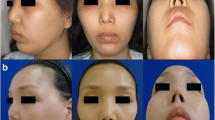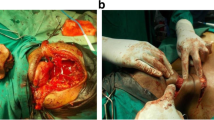Abstract
Advanced nasal cancers usually demand partial or total rhinectomy followed by radiotherapy. Reconstruction of the resulting defects can be achieved by means of reconstructive plastic surgery and/or epithetic surgery. The data of 22 patients who had been treated after nasal ablation by means of custom-made silicone nasal epithesis fixed by bone-anchored magnets between 2003 and 2014 were evaluated retrospectively. There were 15 male (68.2 %) and 7 (31.8 %) female patients. The most common etiology that led to epithetic rehabilitation was a squamous cell carcinoma in 16 patients. An operative revision was necessary in two patients due to screw loss. Twenty patients were still alive with no evidence of disease after minimum follow-up of 2 years (90.9 %). Epithetic rehabilitation after nasal ablation to treat nasal malignancies is an interesting alternative to plastic and reconstructive surgery. Bone-anchored fixation using magnets can achieve a stable epithetic fixation after nasal ablation necessitating, in numerous cases, additional adjuvant therapy like radiation.

Similar content being viewed by others
References
Fischer H, Gubisch W (2008) Nasal reconstruction: a challenge for plastic surgery. Dtsch Arztebl Int. 105:741–746
Korfage A, Raghoebar GM, Noorda WD, Plaat BE, Vissink A, Visser A (2016) Recommendations for implant-retained nasal prostheses after ablative tumor surgery: minimal surgical aftercare, high implant survival, and satisfied patients. Head Neck 38(Suppl 1):E619–E624
Rohrich RJ, Griffin JR, Ansari M, Beran SJ, Potter JK (2004) Nasal reconstruction–beyond aesthetic subunits: a 15-year review of 1334 cases. Plast Reconstr Surg. 114:1405–1416 (discussion 1417-9)
Papaspyrou G, Garbe C, Schadendorf D, Werner JA, Hauschild A, Egberts F (2011) Mucosal melanomas of the head and neck: new aspects of the clinical outcome, molecular pathology, and treatment with c-kit inhibitors. Melanoma Res 21:475–482
Chipp E, Prinsloo D, Rayatt S (2011) Rhinectomy for the management of nasal malignancies. J Laryngol Otol 125:1033–1037
Sertel S, Pasche P (2015) Pericranial flap for inner lining in nasal reconstruction. Ann Plast Surg (Epub ahead of print)
Park SS (2000) Reconstruction of nasal defects larger than 1.5 cm in diameter. Laryngoscope 110:1241–1250
Menick FJ (2002) A 10-year experience in nasal reconstruction with the three-stage forehead flap. Plast Reconstr Surg 109:1839–1855 (discussion 1856-61)
Wax MK, Burkey BB, Bascom D, Rosenthal EL (2003) The role of free tissue transfer in the reconstruction of massive neglected skin cancers of the head and neck. Arch Facial Plast Surg 5:479–482
Malard O, Lanhouet J, Michel G, Dreno B, Espitalier F, Rio E (2015) Full-thickness nasal defect: place of prosthetic reconstruction. Full-thickness nasal defect: place of prosthetic reconstruction. Eur Ann Otorhinolaryngol Head Neck Dis 132:85–89
Tjellström A, Lindström J, Hallen O, Albrektsson T, Brånemark PI (1981) Osseointegrated titanium implants in the temporal bone. A clinical study on bone-anchored hearing aids. Am J Otol 2:304–310
Tjellström A, Lindström J, Nylen O, Albrektsson T, Brånemark PI, Birgersson B, Nero H, Sylven C (1981) The bone-anchored auricular episthesis. Laryngoscope 91:811–815
Federspil PA (2010) Auricular prostheses. Adv Otorhinolaryngol 68:65–80
Federspil PA (2009) Implant-retained craniofacial prostheses for facial defects. GMS Curr Top Otorhinolaryngol Head Neck Surg. doi:10.3205/cto000055
Schaaf NG (1984) Maxillofacial prosthetics and the head and neck cancer patient. Cancer 54:2682–2690
Brånemark PI, Hansson BO, Adell R, Breine U, Lindström J, Hallen O, Öhman A (1977) Osseointegrated implants in the treatment of edentulous jaw: experience from a 10-year period. Scand J Plast Reconstr Surg 16:1–132
Alvi R, McPhail J, Hancock K (2002) Closed-field titanium magnets for the retention of complex craniofacial prostheses. Br J Plast Surg 55:668–670
Scolozzi P, Jaques B (2004) Treatment of midfacial defects using prostheses supported by ITI dental implants. Plast Reconstr Surg 114:1395–1404
Schoen PJ, Raghoebar GM, van Oort RP, Reintsema H, van der Laan BF, Burlage FR, Roodenburg JL, Vissink A (2001) Treatment outcome of bone-anchored craniofacial prostheses after tumor surgery. Cancer 92:3045–3050
Curi MM, Oliveira MF, Molina G, Cardoso CL, Oliveira Lde G, Branemark PI, Ribeiro Kde C (2012) Extraoral implants in the rehabilitation of craniofacial defects: implant and prosthesis survival rates and peri-implant soft tissue evaluation. J Oral Maxillofac Surg 70:1551–1557
Ethunandan M, Downie I, Flood T (2010) Implant-retained nasal prosthesis for reconstruction of large rhinectomy defects: the Salisbury experience. Int J Oral Maxillofac Surg 39:343–349
Sandner A, Bloching M (2009) Retrospective analysis of titanium plate-retained prostheses placed after total rhinectomy. Int J Oral Maxillofac Implants 24:118–123
Robb GL, Marunick MT, Martin JW, Zlotolow IM (2001) Midface reconstruction: surgical reconstruction versus prosthesis. Head Neck 23:48–58
Leonardi A, Buonaccorsi S, Pellacchia V, Moricca LM, Indrizzi E, Fini G (2008) Maxillofacial prosthetic rehabilitation using extraoral implants. J Craniofac Surg 19:398–405
Granström G (2005) Osseointegration in irradiated cancer patients: an analysis with respect to implant failures. J Oral Maxillofac Surg 63:579–585
Author information
Authors and Affiliations
Corresponding author
Ethics declarations
Conflict of interest
The authors declare that they have no conflict of interest.
Research involving human participants and/or animals
Ethical approval All procedures performed in studies involving human participants were in accordance with the ethical standards of the institutional and/or national research committee and with the 1964 Helsinki declaration and its later amendments or comparable ethical standards. For this type of study, formal consent is not required.
Informed consent
Informed consent was obtained from all individual participants included in the study.
Rights and permissions
About this article
Cite this article
Papaspyrou, G., Schick, B., Schneider, M. et al. Epithetic nasal reconstruction for nasal carcinoma: retrospective analysis on 22 patients. Eur Arch Otorhinolaryngol 274, 867–872 (2017). https://doi.org/10.1007/s00405-016-4312-y
Received:
Accepted:
Published:
Issue Date:
DOI: https://doi.org/10.1007/s00405-016-4312-y




